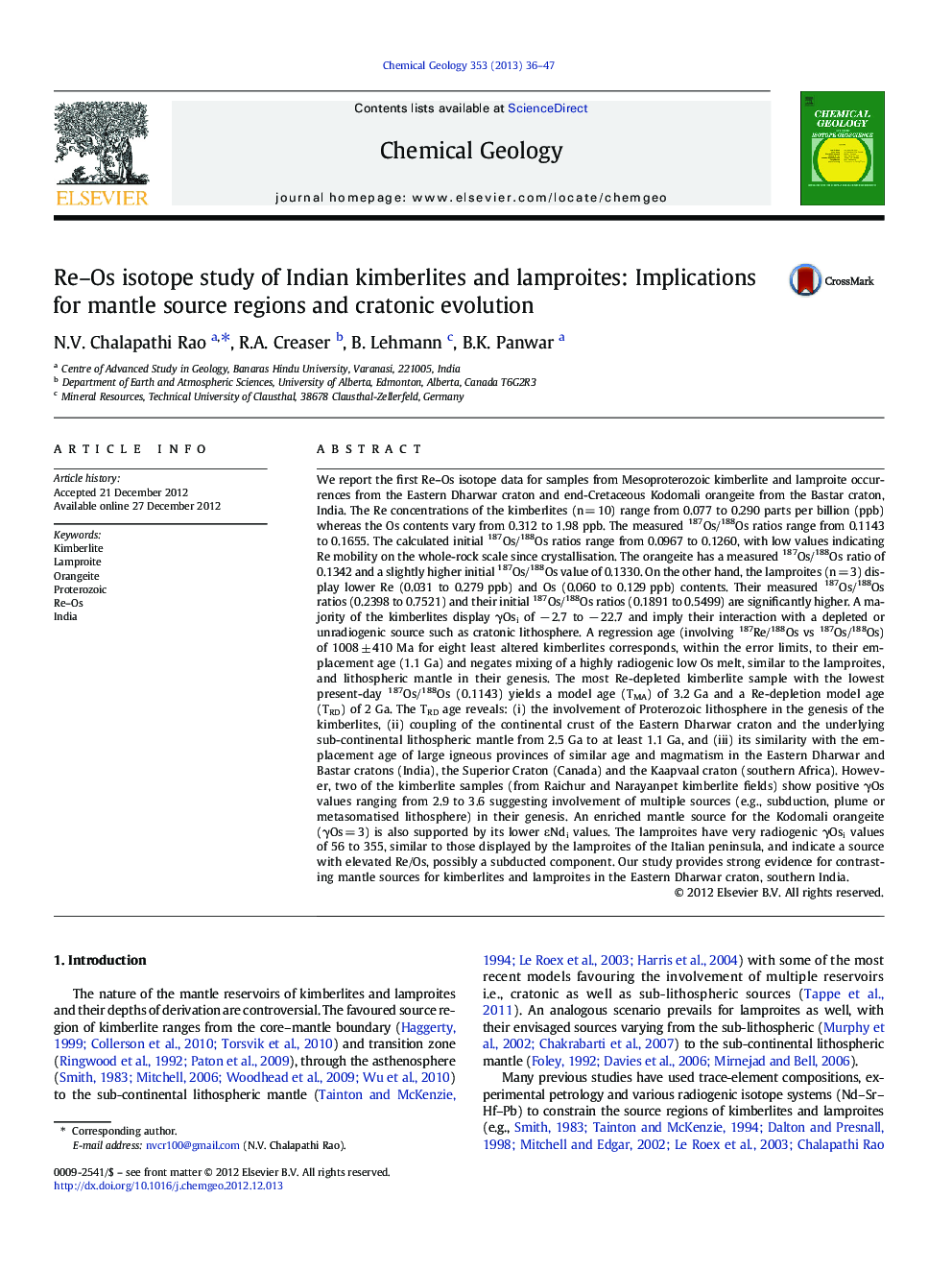| کد مقاله | کد نشریه | سال انتشار | مقاله انگلیسی | نسخه تمام متن |
|---|---|---|---|---|
| 4698929 | 1637616 | 2013 | 12 صفحه PDF | دانلود رایگان |

We report the first Re–Os isotope data for samples from Mesoproterozoic kimberlite and lamproite occurrences from the Eastern Dharwar craton and end-Cretaceous Kodomali orangeite from the Bastar craton, India. The Re concentrations of the kimberlites (n = 10) range from 0.077 to 0.290 parts per billion (ppb) whereas the Os contents vary from 0.312 to 1.98 ppb. The measured 187Os/188Os ratios range from 0.1143 to 0.1655. The calculated initial 187Os/188Os ratios range from 0.0967 to 0.1260, with low values indicating Re mobility on the whole-rock scale since crystallisation. The orangeite has a measured 187Os/188Os ratio of 0.1342 and a slightly higher initial 187Os/188Os value of 0.1330. On the other hand, the lamproites (n = 3) display lower Re (0.031 to 0.279 ppb) and Os (0.060 to 0.129 ppb) contents. Their measured 187Os/188Os ratios (0.2398 to 0.7521) and their initial 187Os/188Os ratios (0.1891 to 0.5499) are significantly higher. A majority of the kimberlites display γOsi of − 2.7 to − 22.7 and imply their interaction with a depleted or unradiogenic source such as cratonic lithosphere. A regression age (involving 187Re/188Os vs 187Os/188Os) of 1008 ± 410 Ma for eight least altered kimberlites corresponds, within the error limits, to their emplacement age (1.1 Ga) and negates mixing of a highly radiogenic low Os melt, similar to the lamproites, and lithospheric mantle in their genesis. The most Re-depleted kimberlite sample with the lowest present-day 187Os/188Os (0.1143) yields a model age (TMA) of 3.2 Ga and a Re-depletion model age (TRD) of 2 Ga. The TRD age reveals: (i) the involvement of Proterozoic lithosphere in the genesis of the kimberlites, (ii) coupling of the continental crust of the Eastern Dharwar craton and the underlying sub-continental lithospheric mantle from 2.5 Ga to at least 1.1 Ga, and (iii) its similarity with the emplacement age of large igneous provinces of similar age and magmatism in the Eastern Dharwar and Bastar cratons (India), the Superior Craton (Canada) and the Kaapvaal craton (southern Africa). However, two of the kimberlite samples (from Raichur and Narayanpet kimberlite fields) show positive γOs values ranging from 2.9 to 3.6 suggesting involvement of multiple sources (e.g., subduction, plume or metasomatised lithosphere) in their genesis. An enriched mantle source for the Kodomali orangeite (γOs = 3) is also supported by its lower εNdi values. The lamproites have very radiogenic γOsi values of 56 to 355, similar to those displayed by the lamproites of the Italian peninsula, and indicate a source with elevated Re/Os, possibly a subducted component. Our study provides strong evidence for contrasting mantle sources for kimberlites and lamproites in the Eastern Dharwar craton, southern India.
► First Re–Os isotopic data for Indian kimberlites and lamproites
► Involvement of Proterozoic lithosphere in kimberlite genesis
► Possible subducted component in lamproite source regions
► Contrasting source regions for kimberlites and lamproites
Journal: Chemical Geology - Volume 353, 30 August 2013, Pages 36–47